You’ll be spending a lot more time outside when the nice weather hits, and it will be even more enjoyable to do so with plants adding beautiful color, smell, and aesthetic appeal to your outdoor space. Flowers, herbs, delicacies, and more may look fantastic in your space, depending on your preferences, and for season-long color, consider planting both annuals and perennials. It’s also simple to switch out any of them from year to year and season to season to offer a new look.
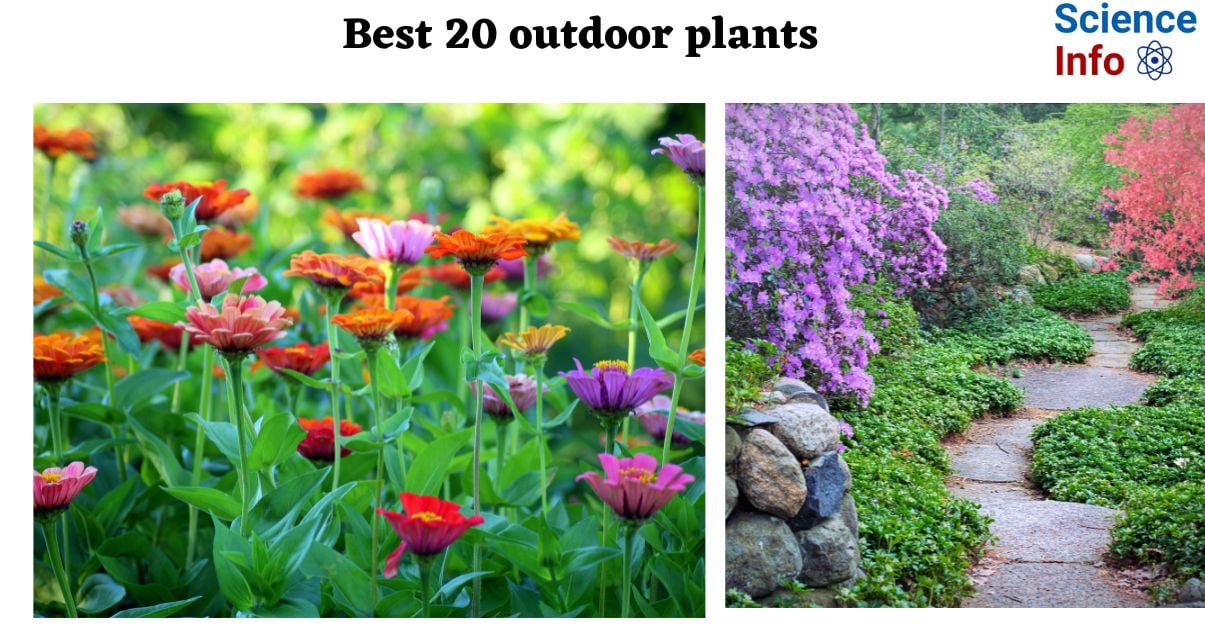
Depending on the plants you choose, they can create a tropical hideaway, a formal entertaining space, a family-friendly area, or a bird and butterfly sanctuary. Whether your patio is in the sun all day or serves as a shaded sanctuary surrounded by trees, there is a perfect bloom to rejuvenate your open-air space. Some of the easiest potted plants thrive in container gardens, while others can be planted in the ground to give privacy screening to your patio. Some people hunt for plants that repel mosquitoes, such as lavender, marigolds, and lemongrass.
Before picking what to plant, consider how much sunlight your patio receives. Is it mostly sunny or mainly shady? When a plant label or description says full sun, it signifies at least 6 hours per day, whereas part sun or part shade means around half that. You should also consider the time of day when your patio receives sunlight. Plants that need partial shade are unlikely to thrive in the intense afternoon sun. Check your USDA hardiness zone to ensure that a plant is suitable for your environment.
These 20 patio plants are ideal for adding foliage, color, and texture to your outdoor haven.
Interesting Science Videos
Best 20 outdoor plants to have in your garden
These are the top 20 list of best 20 outdoor plants to have in your garden.
- Hydrangea
- Kalanchoe
- Million Bells
- Angelonia
- Rose
- Hostas
- Chrysanthemums
- Sweet Alyssum
- Moss rose [Portulaca]
- Begonia
- Wisteria
- Geranium
- Sedum
- Dianthus
- Butterfly weed
- Phlox
- Mint
- Wishbone flowers (Torenia)
- Hyacinth
- Agave
Hydrangea

Hydrangeas are popular attractive garden plants because of their huge flower heads, which come in a variety of colors. Hydrangeas are adaptable shrubs that may grow in sandy coastal soils, shaded woodland areas, and practically anywhere in between. Hydrangeas should be cared for with full light in temperate regions and morning sun in warmer locations, humus-rich soil when available, and continuous watering without waterlogging the plant. Hydrangeas grow rapidly, typically 2 feet or more per year.
Hydrangeas, which grow in zones 3 to 9, are a low-maintenance plant that will return year after year if properly cared for. Adjusting the acidity or alkalinity of your soil might affect the color of your hydrangea petals. Please be warned that the plant is hazardous to animals.
| Plant Type | Shrub |
| Mature Size | 2-20 ft. tall, 2-6 ft. wide |
| Sun Exposure | Full, partial |
| Soil Type | Moist, well-drained |
| Soil pH | Acidic, neutral, alkaline |
| Bloom Time | Summer, fall |
| Flower Color | White, blue, pink, red, purple, green |
| Hardiness Zones | 5—9 (USDA) |
| Native Area | Asia, North America |
| Toxicity | Toxic to pets |
Kalanchoe
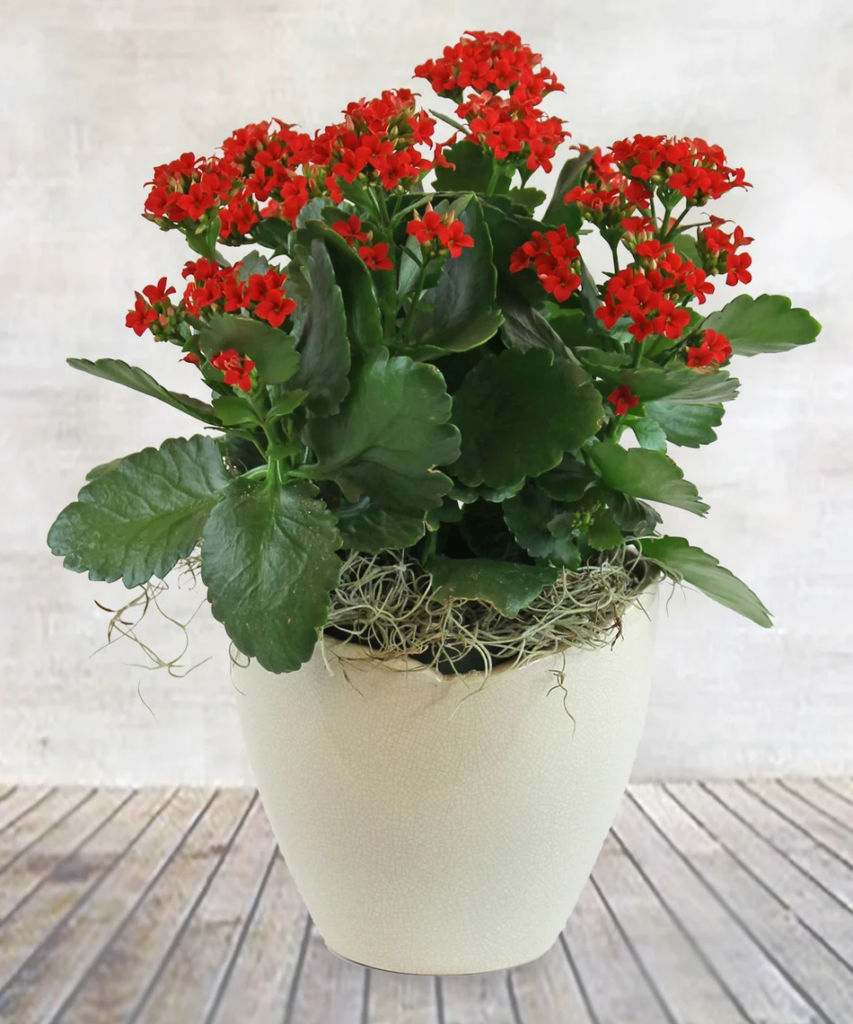
[Image source: https://sweetpeasfloral.com/]
Kalanchoe plants are recognized for their succulent, oval-shaped green leaves with scalloped edges. When exposed to enough sunshine, some cultivars produce crimson leaves or leaf margins. The most common houseplant is Kalanchoe blossfeldiana, which produces clusters of tiny, bright flowers in red, pink, yellow, orange, salmon, and white.
Kalanchoe is a low-maintenance plant, both indoors and outdoors. Kalanchoe blooms best in a brightly lit window within a home. Potted kalanchoe plants thrive in sunny patios or entry gardens. Kalanchoe is a popular houseplant due to its drought tolerance and ease of growth In tropical and subtropical climes, it can be grown as a perennial. In colder climes, it is commonly grown as an indoor plant. It is important to note that all plant parts are harmful to cats and dogs.
| Plant Type | Perennial, succulent |
| Mature Size | 6–18 in. tall and wide |
| Sun Exposure | Full sun, partial shade |
| Soil type | Sandy, well-drained |
| Soil pH | Acidic, neutral, slightly alkaline |
| Bloom Time | Seasonal bloomer |
| Flower Color | Yellow, red, orange, salmon, pink, white |
| Hardiness Zones | 10–12 (USDA) |
| Native Area | Africa (Madagascar) |
| Toxicity | Toxic to pets |
Million Bells [Calibrachoa]

Million bells, also known as Calibrachoa and small petunia, is a perennial, flowering plant that is commonly maintained as an annual, blooming continuously from spring to winter with no need for deadheading. While Calibrachoa million bells is a relatively new species, this stunning tiny plant is a must-have for the garden. Its name derives from the fact that it has hundreds of little, bell-shaped flowers that resemble miniature Petunias. Its trailing tendency makes it ideal for use in hanging baskets, containers, or as a small-area ground cover.
These flowers grow best in warm climes, loving full sun, and moist, well-drained soils, and look stunning in hanging baskets. Million bells, also known as trailing petunia, is a fragile perennial that produces mounds of foliage along trailing branches and blooms in violet, blue, pink, crimson, magenta, yellow, bronze, and white. It grows only 3 to 9 inches (7.5-23 cm. tall). Million bells plants are known to attract hummingbirds, particularly when grown in hanging baskets.
| Plant Type | Perennial, herbaceous |
| Mature Size | 3-9 in. tall, 6-24 in. wide |
| Sun Exposure | Full, partial |
| Soil Type | Loamy, silt, moist but well-drained |
| Soil pH | Neutral, acidic |
| Bloom Time | Spring, Summer, Fall |
| Flower Color | Yellow, orange, purple, red |
| Hardiness Zones | 7-11 (USDA) |
| Native Area | South America, Central America |
| Toxicity | Not Toxic |
Angelonia

Angelonia (also known as summer snapdragon) is a stunning addition to any garden’s color palette. Angelonia is a strong perennial that can withstand summer’s heat and humidity, making it a hearty and colorful addition to any sunny place. Angelonia is planted as an annual in lower locations but as a perennial in USDA cold hardiness zones 9 and above. This plant requires direct sunlight and moist, well-drained soil. Angelonia is not considered harmful to dogs or cats.
There are several Angelonia choices. Some series have the biggest bloom size, while others have miniature plants (ideal for container culture).
There are several Angelonia options. Some series have the biggest bloom size, while others have miniature plants (ideal for container culture).
Serena Purple Angelonia (Angelonia angustifolia) is one of the most highly regarded angelonias. Serena flowers have a long flowering season and are dependable and resilient even in hot summer weather.
| Plant Type | Perennial |
| Mature Size | 12-24 in tall, 9-12 in. wide |
| Sun Exposure | Full |
| Soil Type | Moist, well-drained |
| Soil pH | Acidic |
| Bloom Time | Summer |
| Flower Color | White, pink, purple |
| Hardiness Zones | 9-11 (USDA) |
| Native Area | North America, Caribbean |
| Toxicity | Not Toxic |
Rose

Rose bushes, scientifically known as Rosa spp., are shrubs known for their aromatic flowers, which come in red, pink, apricot, yellow, white, and a variety of other colors. Some rose bushes grow erect, while others cascade or climb. Their stalks are woody and covered with sharp thorns. Although roses are commonly thought to be delicate, part of this notion may stem from aficionados’ annual quest for immaculate blossoms. In reality, roses are quite hardy and can thrive with little effort.
The Rosa genus has around 300 species of woody blooming perennials, and several thousand rose varieties have been grown within those species.
While native roses can be found on almost every continent, the majority of landscape roses are multigenerational hybrid varieties whose origins have long been forgotten. When purchasing a modern rose variety, it is usually typically offered under a unique cultivar name rather than the species name.
| Plant Type | Deciduous shrub |
| Mature Size | 6 inches to 20 feet in height and width |
| Sun Exposure | Full sun |
| Soil Type | Loamy, well-drained |
| Soil pH | Slightly acidic to neutral (6.5 to 6.8) |
| Bloom Time | Spring, Summer, Fall |
| Flower Color | White, red, pink, yellow, orange |
| Hardiness Zones | 2 to 11, depending on type; USDA |
| Native Area | Europe, Asia, North America |
| Toxicity | Not Toxic |
Hostas
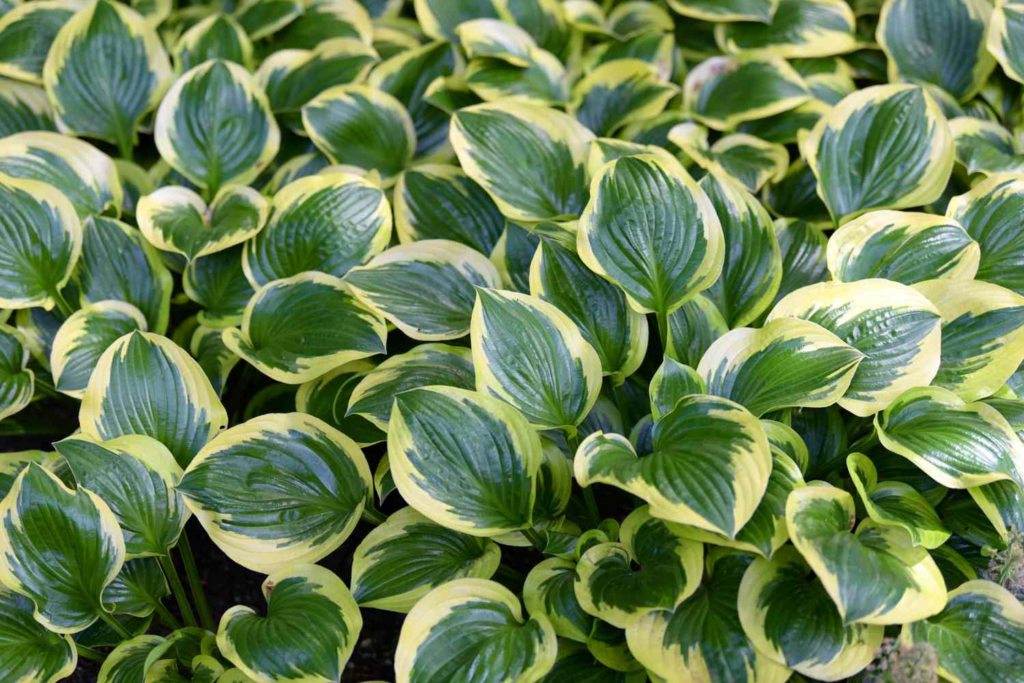
Hostas are known as the queen of shade garden plants. They are herbaceous perennials that are well-liked by gardeners because they can withstand shade. Hostas are popular among gardeners because of their low maintenance requirements. Hostas offer versatility in size, height, texture, and color. They are appropriate for a variety of environments (patio, border, container, rock, shade) and are cold-hardy.
Most varieties have a spread and height of 1 to 3 feet, however larger and smaller sizes are frequently available. Leaf colors include variegated white, lime green, and blue-green, to name a few. Hosta leaves come in a range of textures and shapes, including smooth and thin, ridged, and heart-shaped.
Though the plants are most known for their distinctive foliage, they also produce stunning blooms in pink, lavender, light blue, or white from early summer to early fall. Hummingbirds and other pollinators appreciate the blossoms, which can be fragrant depending on the variety. Hostas can be planted in early spring or as soon as the summer heat has subsided in early October. Keep in mind that hostas are toxic to pets, so choose your planting areas wisely.
| Plant Type | Herbaceous, perennial |
| Mature Size | 6–48 in. tall, 10–60 in. wide |
| Sun Exposure | Shade, partial |
| Soil Type | Loamy, well-drained |
| Soil pH | Acidic |
| Bloom Time | Summer |
| Flower Color | White, purple, pink |
| Hardiness Zones | 3–9 (USDA) |
| Native Area | Asia |
| Toxicity | Toxic to pets |
Chrysanthemums
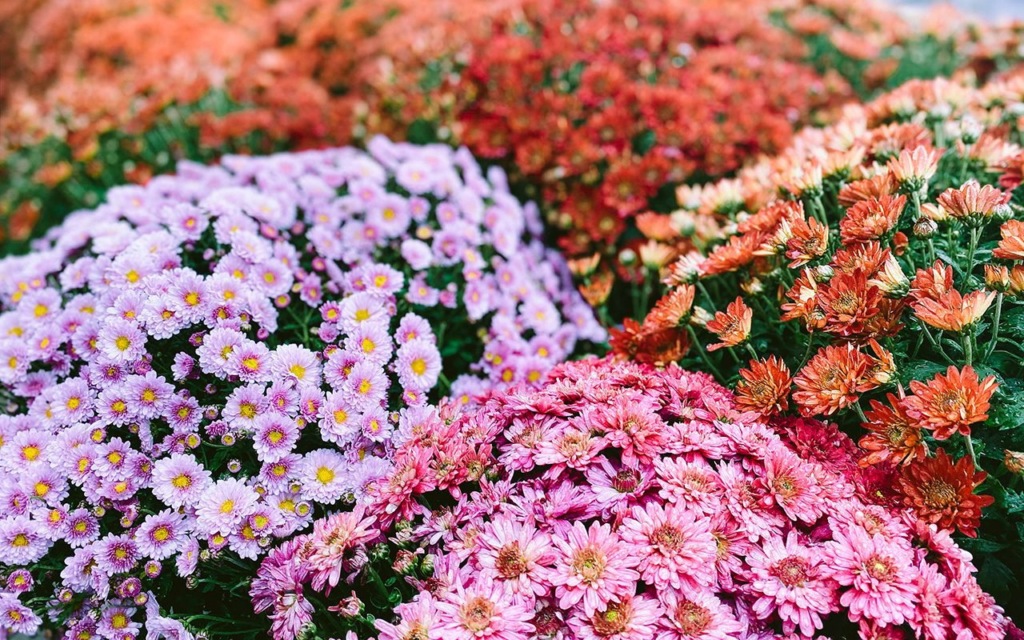
[Image source: https://www.tasteofhome.com/]
Chrysanthemums, or “mums,” are the perfect autumn flower. Chrysanthemums (Chrysanthemum morifolium) is the Queen of Fall Flowers, enjoying the season in a variety of jewel colors including yellow, lavender, pink, purple, red, bronze, orange, and white. To entice gardeners to acquire these late-season bloomers, they are frequently sold in full bloom. That is excellent if all you want is a fast seasonal adornment, but it is not ideal if you are looking for a sturdy perennial plant. Plant them in the spring to allow them plenty of time to establish roots and bloom for years.
You can always grow mums as annuals. They certainly produce beautiful fall colors and are excellent at filling in empty spaces where summer bloomers have faded, especially given their ability to grow to heights of up to 3 feet. Look for plants with a lot of unopened buds to ensure blooms throughout the fall season.
If you own dogs, cats, or horses, you should be aware that chrysanthemums are poisonous to them.
| Plant Type | Herbaceous, perennial |
| Mature Size | 2-3 ft. tall |
| Sun Exposure | Full |
| Soil Type | Rich, moist |
| Soil pH | Acidic, neutral |
| Bloom Time | Summer, fall |
| Flower Color | White, yellow, orange, red, pink, purple |
| Hardiness Zones | 3-9 (USDA) |
| Native Area | Asia, Europe |
| Toxicity | Toxic to pets |
Sweet Alyssum

[Image source: https://www.amazon.com/]
Alyssum is a small and attractive, easy-to-grow summer flowering hardy annual known by various common names, including sweet alyssum or Alison for its strong, sweet perfume and ‘carpet of snow’ for its abundance of tiny white flowers. The botanical name for alyssum is Lobularia maritima. There are pink, purple, and white variants, and the flowers are often so abundant that the short lance-shaped green leaves are hardly discernible.
Native to Europe, the low-growing foliage spreads swiftly, covering the ground with small cross-shaped, four-petal flowers within two months after seeding. The gray-green leaves are slightly hairy, thin, and lance-shaped.
Sweet alyssum is a cool-season flower that can be planted in early April after all danger of frost has passed. It is easy to grow from plants or seeds. Most types will fade in the heat and bloom again in the fall.
WARNING: Sweet alyssum is on California’s invasive species list, and it grows quickly in Hawaii and other warm areas.
| Plant Type | Herbaceous perennial |
| Mature Size | 3–10 in. tall, 2–4 in. wide |
| Sun Exposure | Full or partial |
| Soil Type | Moist but well-drained |
| Soil pH | Neutral to acidic |
| Bloom Time | Spring, fall |
| Flower Color | White, pink, purple |
| Hardiness Zones | 5–9 (USDA) |
| Native Areas | Europe |
| Toxicity | Non-Toxic |
Moss rose [Portulaca]

Portulaca grandiflora, which means ‘large-flowered,’ gives a plethora of vibrant blossoms to any garden. Often called as Moss rose plants, these are well-liked annual succulents with flowers that die after one year.
Moss rose, which is native to South America, can grow to be 3 to 9 inches tall and spread to form a dense mat, making it an excellent choice for a succulent ground cover. The flowers come in a variety of vivid hues and frequently have ruffled petals, resembling small roses.
These plants thrive in poor, dry soils where many other plants struggle—in fact, too much water can kill them. Moss roses normally bloom from summer until the first frost in the fall, with no deadheading required. Annuals die at the end of the growing season, but they produce seeds that may germinate and sprout the following year.
The blooms form clusters on reddish stems and usually do not open on overcast days or at night. Moss rose is best planted in the spring, when the risk of frost has passed. Gardeners should carefully select where they grow moss roses in their landscape. All parts of the plant are harmful to dogs and cats.
| Plant Type | Annual flowering succulent |
| Mature Size | 3–8 in. tall, 6–12 in. wide |
| Sun Exposure | Full |
| Soil Type | Sandy, well-drained |
| Soil pH | Neutral to Acidic |
| Bloom Time | Early summer to frost |
| Flower Color | White, orange, yellow, red, pink |
| Hardiness Zones | 2–11 (USDA) |
| Native Area | South America |
| Toxicity | Toxic to dogs, toxic to cats |
Begonia

Begonias are a stunning plant native to tropical and subtropical climates. Begonia is a genus that includes around 2000 plant species. Because of how easily begonias may hybridize, there are thousands of different species and cultivars available. Many people cultivate begonias for their beautiful, brightly colored blossoms, which range in color from white, yellow, and orange to pink and red. Many varieties have beautiful foliage. Some plants produce single flowers with only one row of petals, but others produce double blooms with many rows of petals.
With so many different species of begonias, there is no hard and fast rule about their hardiness—but in warmer climates, they can be grown as perennials, while in colder zones, they can be grown as annuals and/or overwintered. Some animals may find the roots poisonous.
| Plant Type | Tropical evergreen, annual |
| Mature Size | Varies, 6-18 inches |
| Sun Exposure | Partial sun to shade |
| Soil Type | Moist, rich, slightly acidic |
| Soil pH | 5.7 – 6.2 |
| Bloom Time | Varies, seasonal |
| Flower Color | Pink, red, white, yellow, orange |
| Hardiness Zones | 9-10 (USDA), some varieties 6-9 |
| Native Areas | South and Central America, Africa, South Asia |
| Toxicity | Roots may be toxic to some animals |
Wisteria
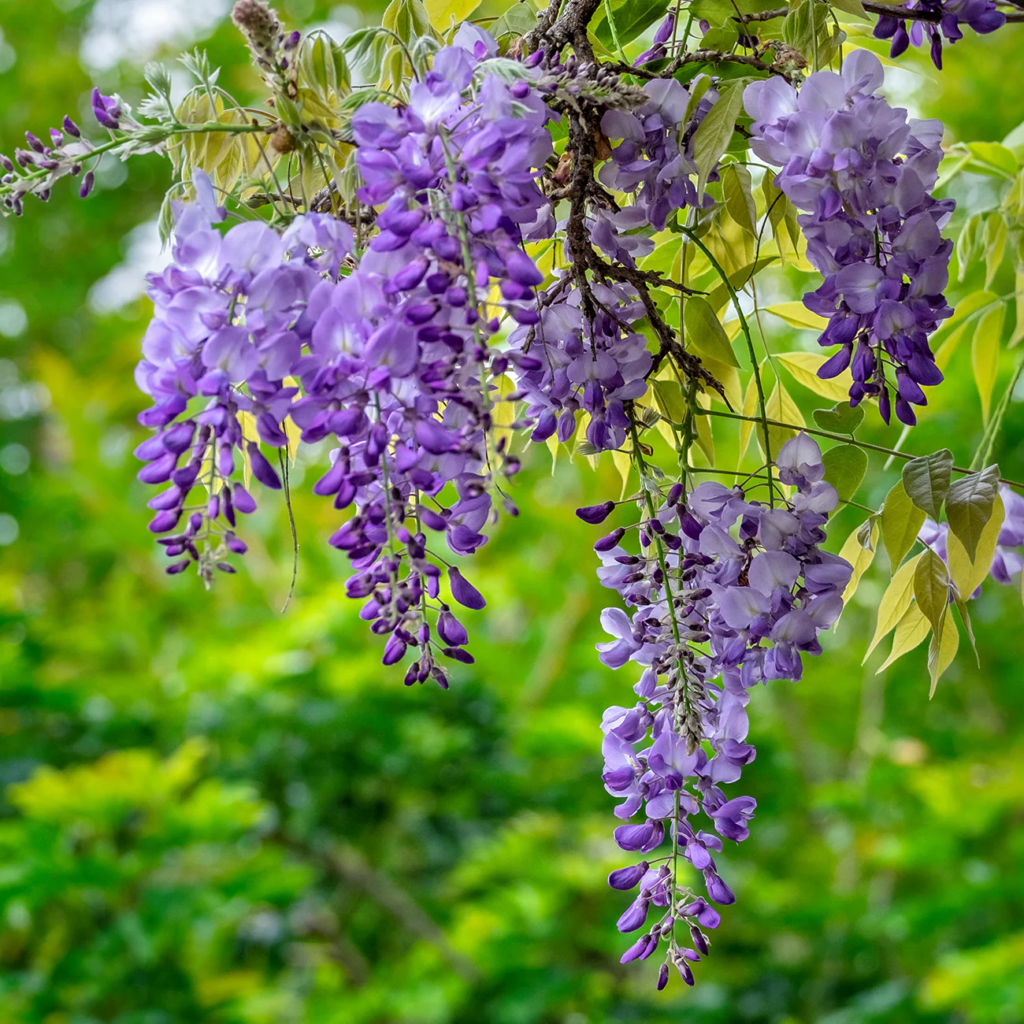
[Image source: https://myperfectplants.com/products/]
A mature wisteria in full bloom is a breathtaking sight. Wisteria is a deciduous climbing shrub that produces gorgeous pendants of fragrance flowers in May or June. You can use these robust climbers to cover your house or garden walls, or, less formally, to climb mature trees from which blossoms will cascade down. Young plants may be slow to flower, but be patient and you will be rewarded. In the fall, flowering plants give way to bean-like pods. The leaves are pinnate (shaped like feathers).
There are three major types: two Asian and one American. They often appear so identical that it is difficult to tell them apart, but one distinguishing trait is the pods. Those of the Asian kind are covered in fuzz, whereas those of the American variety are smooth.
Chinese and Japanese wisteria are invasive in North America. This is another reason why some North Americans prefer to plant American wisteria.
Wisteria is a big vine that thrives in open spaces. The trunk eventually grows huge, reaching a weight that might topple weak supports. Give this twining vine a strong arbor for support. Wisteria is a hazardous plant, therefore use caution while growing it around children and pets.
| Plant Type | Deciduous, perennial vine |
| Mature Size | 10 to 25 feet long, 4 to 8 feet wide |
| Sun Exposure | Full sun, partial shade |
| Soil Type | Well-drained |
| Soil pH | Slightly acidic to neutral |
| Hardiness Zones | 5 to 9 (USDA) |
| Native Area | Northern Hemisphere |
| Toxicity | All parts contain the harmful chemicals lectin and wisterin |
Geranium
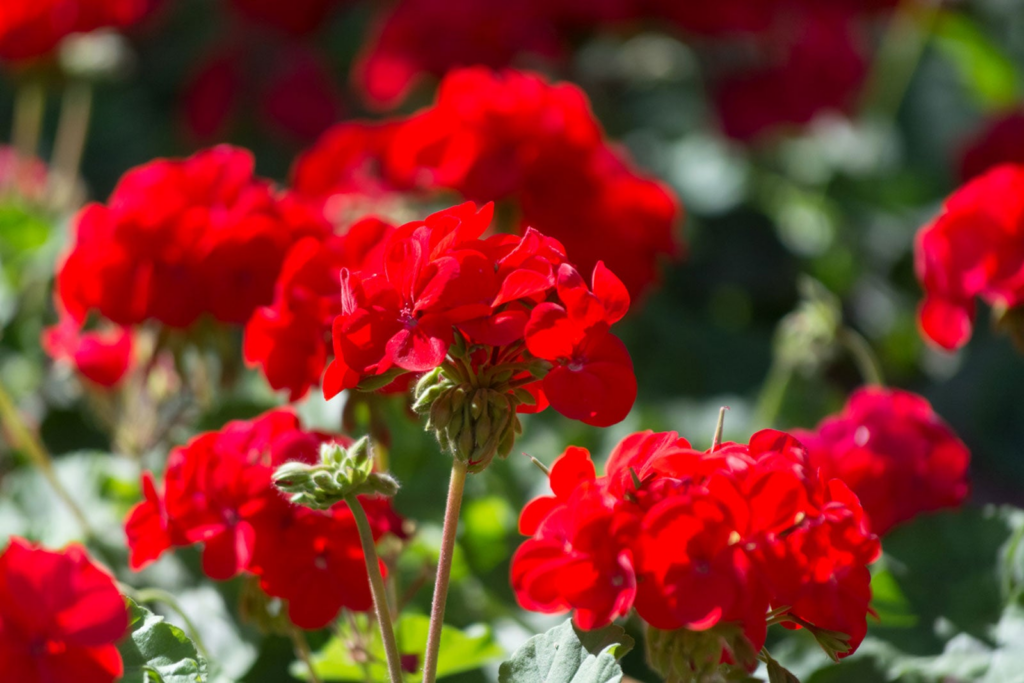
Pelargoniums, often known as common geraniums, are vibrant summer flowering plants that are popular in hanging baskets, pots, and garden beds. Geraniums are not true geraniums. If you point to a geranium in a garden shop, you’re most likely pointing to a Pelargonium, a member of a group of plants often known as ‘geraniums.’ True geraniums are a similar species of hardy flowering perennial shrubs.
Scented geraniums are an excellent addition to herb gardens, borders, window boxes, and hanging baskets due to their beautiful blooms, delightful aromas, and culinary uses.
While there are numerous varieties of this flower, each with its distinct growing patterns, colors, and smells, they all have one thing in common: they add a low-maintenance element to most summer landscapes. Geraniums have a minor harmful effect on dogs, cats, and horses.
| Plant Type | Herbaceous perennial |
| Mature Size | 1 to 3 feet tall and wide, vines to 5 feet |
| Sun Exposure | Full sun, part shade |
| Soil Type | Organically rich, well-drained |
| Soil pH | 6.0 to 6.5 |
| Bloom Time | Spring through autumn |
| Flower Color | Red, purple, pink, orange, white, bi-colors |
| Hardiness Zones | 9 to 12 |
| Native Area | Southern Africa, Australia |
| Toxicity | Toxic to dogs, cats, horses |
Sedum

Sedum is a big-blooming plant genus that can be found on nearly every continent. Many gardeners are looking for plants that require little care and thrive in neglect. Sedums could be ideal for them. Plants come in a range of heights, colors, and shapes. Most sedums, also known as stonecrop, are drought-tolerant succulents with thick, fleshy leaves that come in a variety of colors. They often produce tiny, star-shaped flowers that bloom late in the growing season.
They also serve as magnets for bees and butterflies. Sedums can be annuals, perennials, or even tiny shrubs depending on the climate. There are over 400 kinds. Most are hardy in USDA zones 4–9. Sedums are succulent plants with fleshy leaves. Depending on the choices, the leaf hues range from pale green to blue-gray to reddish-bronze. The little flowers appear in groups of white, yellow, bronze, and pink.
Border sedums look fantastic in spring because their lush green-grey foliage (purple on some kinds) is beautiful in and of themselves. The flower heads are green in the spring and progressively turn pink before fully blossoming in August.
Several plant species previously categorized as sedums have been transferred to different genera. One of the most well-known instances is the popular ‘Autumn Joy’ sedum, now identified botanically as Hylotelephium ‘Autumn Joy.’
| Plant Type | Perennial |
| Mature Size | 6–24 in. tall, 12–24 in. wide |
| Sun Exposure | Full, partial |
| Soil Type | Sandy, loamy, well-drained |
| Soil pH | Acidic, neutral |
| Bloom Time | Summer, fall |
| Flower Color | Red, pink, yellow, white |
| Hardiness Zones | 3–10 (USDA) |
| Native Area | North America, South America, Central America, Europe, Asia, Africa, Mediterranean |
| Toxicity | Non-toxic to humans and pets |
Dianthus

Dianthus blooms add a delightful smell and bright color to sunny borders or containers. This resistant, versatile plant, also known as Carnations, Sweet William, and pinks, grows from low-growing annuals to taller perennials (like carnations). The family of plants is distinguished by the spicy scent of its lovely blossoms, which are sometimes compared to cinnamon and cloves.
Dianthus is popular for a variety of reasons. In addition to being resilient and adaptable, they are long-blooming and will flower profusely throughout the summer season if the faded flowers are deadheaded. And their aroma is exquisite, comparable to cloves. The blooms also bring butterflies, hummingbirds, and other pollinators to the yard.
Dianthus types range from tiny creeping groundcovers to 30-inch-tall cut flowers, which are popular among florists. Some have big, deep crimson spots, while others have color bands around the margins of their petals. Many have multiple blossoms, and some have flowers grouped at the stalk’s tip, giving the appearance of a bouquet.
Dianthus plants grow quickly and are best started in the spring, once the risk of frost has passed. Seedlings can emerge in as little as eight days, and a new plant can be in full bloom in less than three months. Blooms are most abundant in late spring, with some possible reblooming in the fall. Dianthus flowers can be solitary or double, but they all feature the same jagged-edged petals. Every dianthus plant is poisonous to pets.
| Plant Type | Perennial |
| Mature Size | 6–36 in. tall, 6–24 in. wide |
| Sun Exposure | Full sun |
| Soil Type | Moist but well-drained |
| Soil pH | Neutral to acidic |
| Bloom Time | Spring, Summer, and fall |
| Flower Color | White, lilac, red, pink |
| Hardiness Zones | 3-9 (USA) |
| Native Areas | Europe, Asia, Africa |
| Toxicity | Toxic to pets |
Butterfly weed
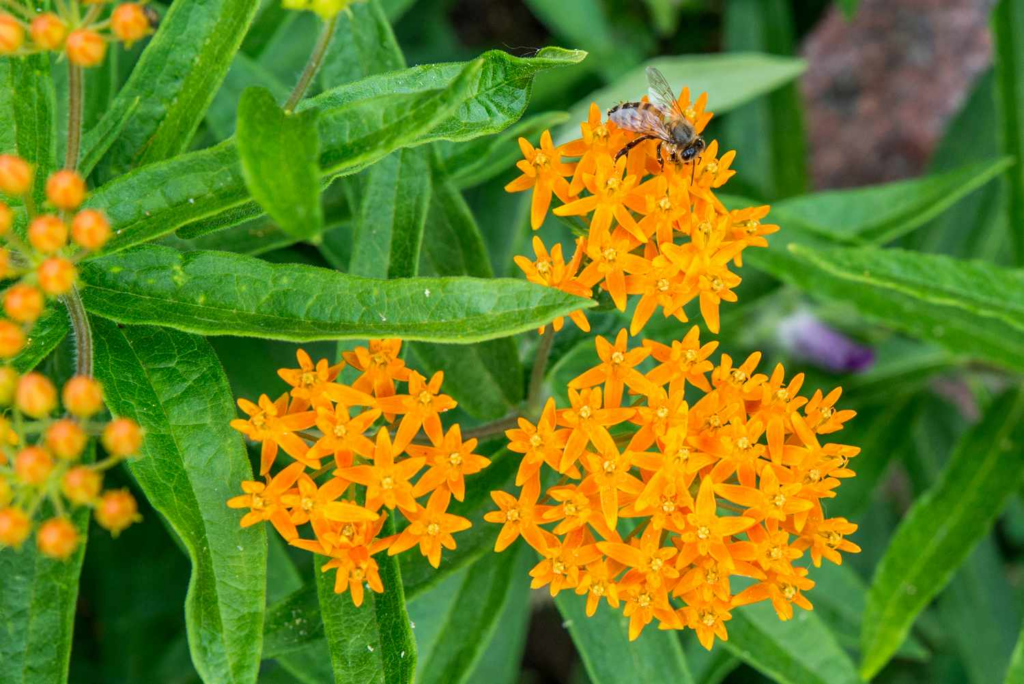
Butterfly weed (Asclepias tuberosa) is planted by gardeners who enjoy viewing butterflies in their gardens. It produces clusters of yellow, orange, and red flowers from late spring to late summer. This clump-forming perennial grows from tuberous roots to a height of one to two feet and is distinguished by glossy-green, lance-shaped leaves and clusters of bright orange-to-yellow blossoms that are high in nectar and pollen.
Butterfly weed, a kind of milkweed, is typically sown in late spring when the soil is warm. It takes some time to gain traction. It does not blossom in the first year; in fact, it can take up to three years to flower. When it eventually blooms, its clusters of beautiful orange-yellow flowers will last around two months, from late spring to late summer. Butterfly weed, unlike other milkweeds, does not have caustic milky fluid, but it does produce distinctive seed pods that release silky-tailed seeds that disperse in the wind.
Butterfly weed is regarded as mildly harmful to both people and animals. Butterfly weed, on the other hand, is considered a safer plant in households with children or pets since it contains significantly less harmful sap than ordinary milkweed.
| Plant Type | Herbaceous, perennial |
| Mature Size | 1–2 ft. tall, 12-18 in. wide |
| Sun Exposure | Full |
| Soil Type | Dry, well-drained |
| Soil pH | Acidic, neutral |
| Bloom Time | Summer |
| Flower Color | Orange, yellow |
| Hardiness Zones | 3–9 (USDA) |
| Native Area | North America |
| Toxicity | Mildly toxic to animals and humans |
Phlox

Phlox is a typical garden plant that comes in approximately 70 different perennial and annual kinds, ranging from creeping to towering, with flowers that bloom from mid-spring to late summer. These perennials produce profuse star-shaped, bright flowers from spring to summer, depending on the type. There are so many different varieties of phlox (many of which are native to North America), that you may find one for practically any garden. Their flexibility cannot be overestimated.
Phlox comes in two varieties: Garden Phlox (Phlox paniculata) and Creeping Phlox (Phlox subulata). Both Garden Phlox and Creeping Phlox produce fragrant blooms that attract a wide range of pollinators, including butterflies and hummingbirds.
Because there are so many distinct species of phlox, their light requirements differ. Tall garden phlox prefers full light, while forest species flourish in moderate shade.
| Plant Type | Herbaceous perennial |
| Mature Size | Up to 5 ft. tall, depending on variety |
| Sun Exposure | Partial to full sun |
| Soil Type | Loamy, rich, well-drained |
| Soil pH | Neutral to acidic |
| Bloom Time | Spring through late summer |
| Flower Color | White, pink, purple, blue |
| Hardiness Zones | 3-9 (USDA) |
| Native Area | North America |
| Toxicity | Non-toxic to humans and pets |
Mint

Mint has a wide range of applications. Its bright green leaves provide a tart kick to fruit salads, ice cream, sherbet, and tea. It’s a tasty addition to any drink of still or sparkling water. A single plant is generally sufficient to supply a summer’s worth of this delightful herb. Mint blooms, in addition to having culinary and fragrant characteristics, attract pollinators.
There are around 600 mint kinds, with spearmint and peppermint being the most often cultivated. Regardless of the kind you choose to grow and harvest, the herb’s flexibility and tenacity make it simple to grow and cultivate, especially for inexperienced gardeners.
Mint plants grow swiftly and should be planted in the spring after the frost threat has passed. Mint is poisonous to animals. Mint is a fast-growing plant that must be kept under control or it will spread throughout your landscape. If you are okay with mint becoming a ground cover and are aware that it may become invasive, plant it in its own raised bed or separate area.
| Plant Type | Perennial, Herb |
| Size | 12–18 in. tall, 18–24 in. wide |
| Sun Exposure | Full sun, Partial sun |
| Soil Type | Loamy, Moist, Well-drained |
| Soil pH | Acidic, Neutral |
| Bloom Time | Summer |
| Hardiness Zones | 3–11 (USDA) |
| Native Area | North America, Afri |
Wishbone flowers (Torenia)

[Image source: https://www.martinnursery.com/torenia/]
Wishbone flowers (Torenia fournieri) are a fantastic choice for adding color and vibrancy to a shadier area of the garden. The wishbone flower is a perennial that is traditionally planted as an annual. Its name comes from the stamens, which create wishbone forms. It is also known as a clown flower because the blooms’ patterns and brilliant colors resemble clown makeup. Unlike many other annual blooms, these small plants may thrive in partial shade. Their trumpet-shaped flowers are available in a variety of colors; the predominant species colors are dark blue-purple and lavender with yellow markings.
Plants typically grow to be around 6 inches tall and can trail up to 30 inches, making them ideal for the front of a landscape bed, the edge of a container, or a hanging basket. Plant wishbone flowers in the spring, when the danger of frost has passed. While they are annuals that will perish with the first fall frost, they grow swiftly and bloom profusely from early summer until the cold weather arrives. Furthermore, the plants repel deer and attract hummingbirds.
| Plant Type | Annual |
| Mature Size | 6–12 inches tall, 6–9 inches wide |
| Sun Exposure | Partial shade |
| Soil Type | Loamy, well-drained |
| Soil pH | Acidic, neutral |
| Bloom Time | Spring, summer |
| Flower Color | Bi-colors of pale violet and dark purple, yellow and dark purple, dark purple and white, pink and white |
| Hardiness Zones | Grows in zones 2 -11 |
| Native Area | Asia |
| Toxicity | Non-Toxic to humans and pets |
Hyacinth

[Image source: https://www.bunnings.com.au/diy-advice/garden/]
Hyacinths smell like spring. Their strong aroma lingers in the air, indicating that winter has passed and spring has arrived. Hyacinths, like tulips and daffodils, are quintessential spring flowers. Hyacinths (Hyacinthus orientalis) make lovely accents to Southern gardens. They add brilliant floral color with tall spikes of eye-catching blossoms and bright green foliage. Hyacinths are part of the Asparagaceae family. They are perennials that produce eye-catching, fragrant flowers that you will look forward to seeing each year.
Hyacinths are spring-blooming bulbs with vividly colored blossoms and a smell that can permeate the entire garden. They bloom in mid-spring, among daffodils and early tulips, and come in a variety of colors, including white, cream, pink, rose, apricot, lavender, cobalt blue, deep purple, and wine red. Hyacinths, like other spring-flowering bulbs, are quite straightforward to grow. Simply plant the bulbs in the fall and enjoy the gorgeous blossoms the following spring.
Even from a distance, you’ll notice the blossoms’ strong aroma and the spikes of bright tubular flowers that emerge from strap-shaped leaves. Hyacinths were introduced to Europe in the 16th century, and their popularity prompted Dutch bulb farmers to create over 2,000 cultivars by the 18th century, with approximately 60 varieties available in commercial cultivation today.
Modern hyacinths are among the easiest perennial spring bulbs to raise. Hyacinths will return year after year, however their flowers will lose vitality after a few seasons. They are best planted in the fall and grow at a modest rate. Hyacinths can be grown outdoors in the ground in pots, or indoors in a water-filled bulb vase. Keep them out of the reach of children and animals. The bulbs are harmful to both people and pets.
| Plant Type | Perennial, bulb |
| Mature Size | 6–12 in. tall, 3–6 in. wide |
| Sun Exposure | Full, partial |
| Soil Type | Moist but well-drained |
| Soil pH | Neutral, acidic |
| Bloom Time | Spring |
| Flower Color | White, blue, purple, pink, red |
| Hardiness Zones | 4–8 (USDA) |
| Native Area | Europe, Asia |
| Toxicity | Toxic to humans and pets |
Agave

[Image source: https://plantsexpress.com/products/blue-american-agave]
Agave plants are succulents with big leaves and pointed points. Native to Mexico, this member of the Agavaceae family is a lifetime commitment, growing slowly over many years until reaching its completion in a burst of growth and a towering blooming stalk.
Their sharp teeth and spines, combined with the rosettes of succulent leaves, add a striking and sculptural aspect to any garden. Agave americana is a stunning addition to any landscape, with its huge rosettes of blue-green leaves adding an exotic touch.
Their foliage has sharp, spiky edges that repel pets and unwelcome garden guests such as insects. These gorgeous succulents are not only beautiful, but they also tolerate hard conditions, thriving in full sun and sandy soil.
| Plant Type | Perennial, succulent |
| Mature Size | 1–20 ft. tall, 1–10 ft. wide (depends on variety) |
| Sun Exposure | Full |
| Soil Type | Sandy, well-drained |
| Soil pH | Acidic, neutral |
| Bloom Time | Varies; most only bloom once in their lifetime |
| Flower Color | Green, white, yellow |
| Hardiness Zones | 5–11, USA |
| Native Area | North America, Central America, South America |
| Toxicity | Toxic to people, toxic to pets |
Also, Find out the best indoor plants to have at your home.
Video Reference
References
- https://www.realsimple.com/home-organizing/gardening/outdoor/impossible-to-kill-outdoor-plants#
- https://www.bhg.com/gardening/design/styles/plants-for-gardening/
- https://www.gardendesign.com/plants/foliage.html
- https://www.housebeautiful.com/lifestyle/gardening/g43854993/outdoor-plants-for-patio/
- https://www.goodhousekeeping.com/home/gardening/g32522444/best-patio-plants/
- https://www.hgtv.com/outdoors/gardens/planting-and-maintenance/low-maintenance-plants-for-easy-landscaping-pictures
- https://www.thespruce.com/

